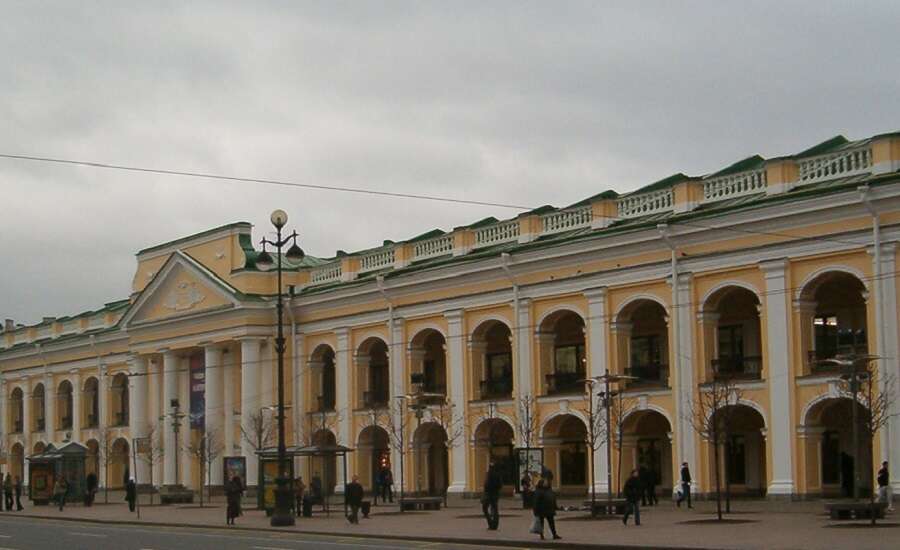
Photo by Potekhin on Wikipedia
On a stroll along Nevsky Prospekt, it is impossible to miss Gostiny Dvor – a vast Classical building which occupies an entire block. Gostiny Dvor was the oldest and largest retail complex in St Petersburg, was one of the world’s first shopping arcades, and remains the largest department store in the city today. Not only is Gostiny Dvor a great place to shop and an impressive architectural monument, but it is one of the symbols of St Petersburg which was inextricably linked with the emerging city’s history.
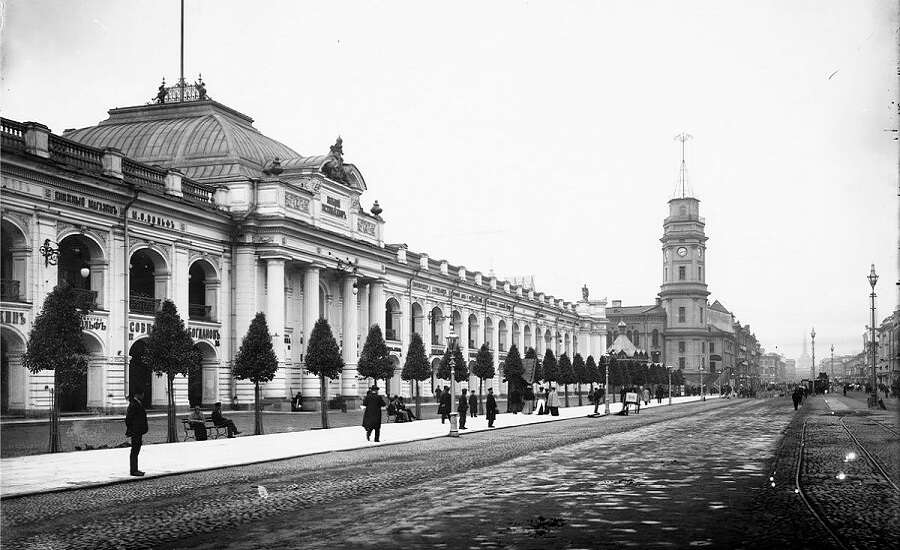
Photo on Citywalls.ru
Before Gostiny Dvor was built, the intersection between Nevsky Prospekt and Sadovaya Street was filled with wooden shops. After fires devastated the growing city in 1736 and 1737, serious plans were made to rebuild St Petersburg in stone, including a decision to erect a stone building to replace the wooden merchants’ shops. This building would be called ‘Gostiny Dvor’ – usually translated as ‘Guests’ Court’ or ‘Merchants’ Yard’.
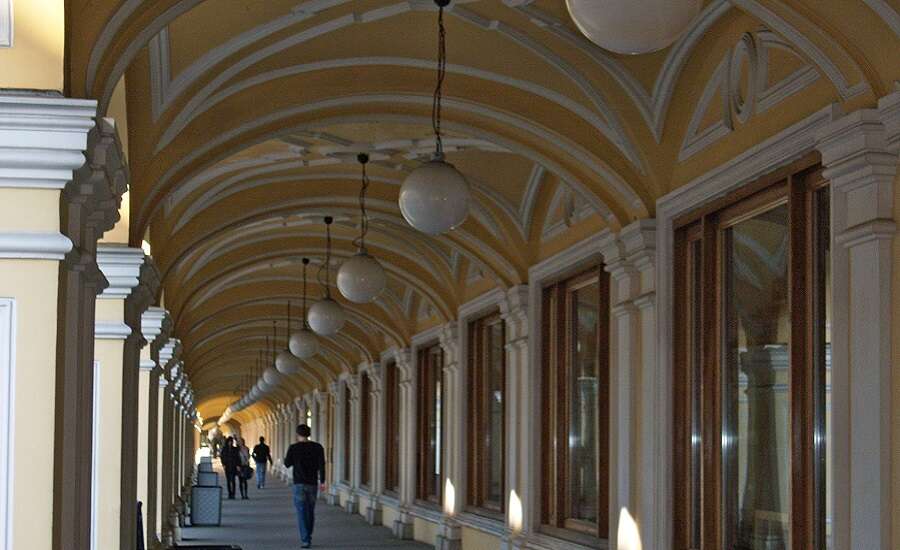
Photo by N. Kucher CC BY-SA 3.0 on Wikipedia
Some of the most renowned architects of the time contributed to the construction of Gostiny Dvor, including Peter Eropkin (the first chief architect of St Petersburg), Antonio Rinaldi (architect of the Grand Palace at Gatchina) and Bartolomeo Rastrelli (architect of the Winter Palace and the Catherine Palace at Tsarskoe Selo). However, several decades passed and several monarchs came and went before Gostiny Dvor’s construction even began – architects fell in and out of favour with the rulers, wars or construction of palaces took precedence in the imperial budget, and merchants opposed the relocation of their wooden shops. Eventually, the design of French architect Jean Baptiste Vallin de la Mothe was chosen, and construction took place between 1761 and 1785. One more architect had a much later influence on Gostiny Dvor’s design. To mark the centenary of Gostiny Dvor, Nikolai Benois redesigned the Classical façade of the building and added elaborate stucco, sculptures and a dome on its central section.
Did you know? Unlike the other buildings on Nevsky Prospekt, which were built strictly along the ‘red line’ (a rule of St Petersburg’s city planning, whereby the façades of buildings had to form an unbroken line along a street), Gostiny Dvor was set back from the road to allow carriages and carts to pull up there without blocking the way.
https://www.citywalls.ru/photo396011.html (some good historical photos here)
The fear of fire was so great that even candles were forbidden, and a special pond was dug in the inner courtyard of Gostiny Dvor in case a fire did break out. As a result, Gostiny Dvor remained unheated and unlit, leading merchants to appeal to the Governor-General of St Petersburg for the “most merciful permission” to install some form of lighting and heating to abate the cold and dark winters. Finally, a furnace was installed in 1837 and gas lighting in 1842 – the first in the city, which drew St Petersburg’s residents for evening walks along the wide boulevard between Nevsky Prospekt and Gostiny Dvor.
Upon completion Gostiny Dvor was home to over one hundred shops, and initially there were specific zones for certain types of trade, which included haberdashery, perfume, stationery, women’s goods, and precious metals. St Petersburg’s book trade first emerged in Gostiny Dvor at the end of the 1700s, and even when the bookselling industry was still in its infancy, there were fifteen bookshops in Gostiny Dvor alone. These were frequented by eminent writers such as Alexander Pushkin. A sprawling hub of trade spilled out of Gostiny Dvor and into the nearby streets, including the so-called ‘Feather Rows’ – a building specifically for female traders. By the 19th century, it was possible to find in Gostiny Dvor any good that was produced in Russia, and all of the city’s most important merchants had a shop there.
Gostiny Dvor was not just a retail zone but a city attraction, a place for entertainment, leisure and socialising where foreign dignitaries and aristocrats, artists and writers, students and workers rubbed shoulders among the merchants’ stalls. Over the decades Gostiny Dvor practically evolved into a city within a city, with its own rules and trading customs. Customers were drawn in by ‘barkers’ who called out to them on the streets, and no prices were displayed – the trader and customer bartered and made an oral agreement on the price. As more and more foreign merchants arrived to trade in Gostiny Dvor, this practice ceased and fixed prices had to be displayed. A special organisation was set up in 1839 – the Gostiny Dvor Management Committee – run by elected members who negotiated between the merchants and city authorities, guarded the shops, and kept the area clean.
This vibrant hub of trade could not but suffer after the October Revolution. The shops in Gostiny Dvor were boarded up and goods were requisitioned by the Committee for the Municipal Economy. Trading ceased entirely between 1918 and 1921, but during the New Economic Policy period (1921-1928), Gostiny Dvor reopened and flourished. One émigré, returning to Leningrad for a visit in 1925, discovered jewellery stores and even shops selling religious clothing and icons.
Did you know? Many merchants believed that the new regime would not last, and some concealed their savings inside Gostiny Dvor. Over the years, treasure troves of gold bars and coins have been discovered during repairs to the building.
During the Siege of Leningrad, Gostiny Dvor was severely damaged by Nazi bombing and subsequent fires, and many of its tenants died. Despite the destruction, plans to restore the building were drawn up in the winter of 1942/43, and restorations began in 1944. On 3rd December 1954, the USSR’s Council of Ministers issued an order to open the Gostiny Dvor Department Store – this date is considered the birthday of Gostiny Dvor. While the exterior was restored to its original design by de la Mothe, Gostiny Dvor’s interior was totally revamped. Instead of separate shops, an open-plan modern department store layout was implemented. The alley of linden trees, which had been torn down in the 1930s on the boulevard of the Nevsky Prospekt façade, was replanted as part of the reconstruction. The metro station ‘Gostiny Dvor’ was also opened in 1967.
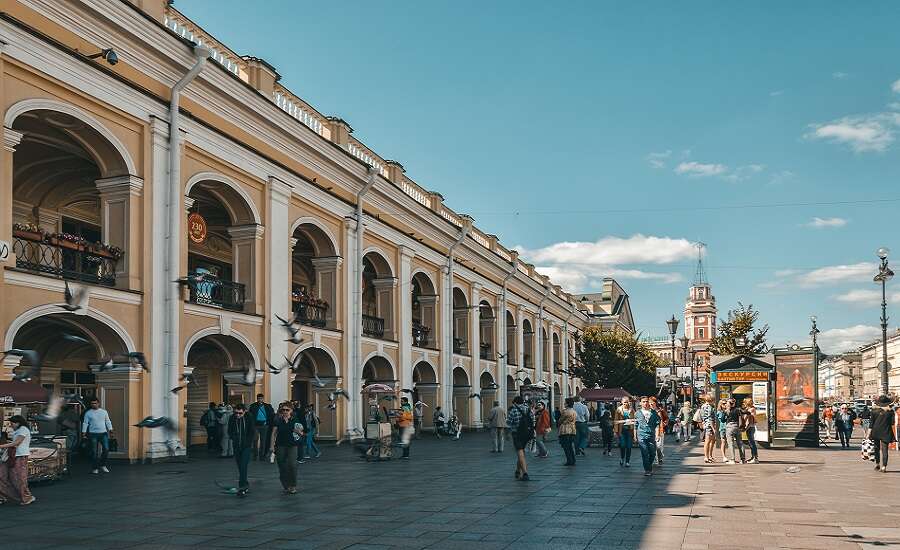
Photo by Skif-Kerch CC BY-SA 4.0 on Wikipedia
Walking the two-kilometre route around Gostiny Dvor’s trading floors, you can browse an enormous variety of products.
On the first floor there are sections for home goods, leather goods, travel accessories, men’s and women’s shoes, jewellery, children’s toys and more. In the food hall visitors can purchase Russian delicacies such as Kamchatka crab, black caviar from Astrakhan sturgeon, bear chorizo and Tula gingerbread, as well as foreign products such as alcoholic beverages, sweets and chocolates, tea, coffee and meat. There is a section for high-quality Russian souvenirs like Khokhloma painting on wooden utensils and ornaments, Gzhel porcelain, Karelian embroidery, Zhostovo paintings on handcrafted metal trays, Vyatka nesting dolls, amber products and Pavlovo Posad shawls.
On the second floor is a large section of men’s and women’s designer clothing, an interior design salon with home décor items, and a wide range of porcelain, crystal and glass goods from several European countries. The Haute Couture Gallery occupies pride of place on this floor. Its grand opening in 1998 brought collections from the couturiers of Italy, France and England to Russia, and it has remained ever since a centre of fashion in St Petersburg. Today it is home to more than 40 world-famous brands including Versace Jeans Couture and Love Moschino.
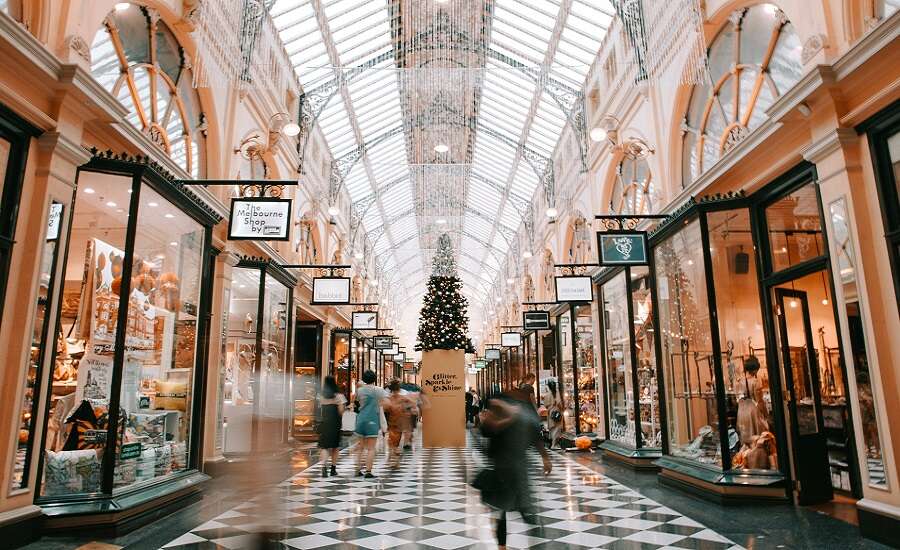
Photo by Heidi Fin on Unsplash
In the inner courtyard of Gostiny Dvor stands a two-storey building built for the Gostiny Dvor Management Committee. Today, it is a monument to the merchant community who contributed so much to St Petersburg. The lower floor of the building is occupied by the Church of the Monk Seraphim Vyritsky. As a child, Vyritsky worked as a messenger boy in Gostiny Dvor, before becoming a monk in the Alexander Nevsky Monastery. He was famous for his prophetic and healing abilities and was canonised in 2002. The upper floor of the building is home to the Museum of Merchant History in St Petersburg and Russia – a small exhibition with historical photographs and adverts, goods from the imperial-era shops of Gostiny Dvor, and items discovered during excavations on the territory.
On the Gostiny Dvor website, you can build your own tour around the department store by selecting the type of products or brands you want to browse, or by choosing from a number of pre-built routes, including For Him, For Her, World of Kids, and Tourist Route.
Russian Museum: The world’s largest collection of Russian art, housed in a former imperial palace.
Church on Spilled Blood: A magnificent cathedral built to commemorate Tsar Alexander II’s assassination on this very spot, with gilded and enamelled domes and an interior entirely covered in mosaic.
Passage: An elite department store built in the mid-19th century, with boutiques lining a 180-metre long, glass-ceilinged passage.
Essential information for visitors
Address: Nevsky Prospekt, 35, St Petersburg, 191186
Website: http://www.bgd.ru/
Phone: +7 (812) 630-54-08
Nearest metro: Gostiny Dvor metro station (green line), entrance inside the Nevsky Prospekt-facing façade of Gostiny Dvor. Nevsky Prospekt metro station (blue line) has an underground link to Gostiny Dvor metro station, entrance by Dom Knigi or by the north-western corner of Gostiny Dvor.
Opening hours: 10:00 – 23:00 daily.
Join us on Facebook
We invite you to become a fan of our company on Facebook and read Russian news and travel stories. To become a fan, click here.
Join our own Russian Travel, Culture and Literature Club on Facebook. The club was created to be a place for everyone with an interest in Russia to get to know each other and share experiences, stories, pictures and advice. To join our club, please follow this link.